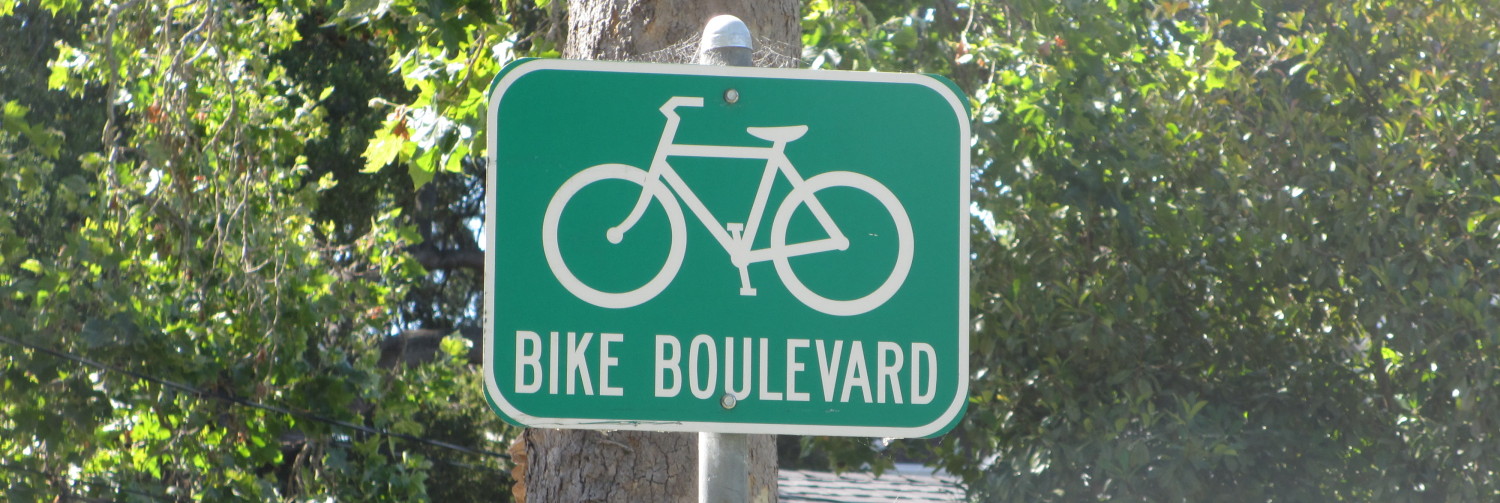The uniformly wide-street problem…
Most city streets are of uniform width for blocks: there are vehicle movement lanes and curb side parking. Sometimes the curbside parking is restricted, catering to more moving vehicles. Streets are the same width even when there is no need, for example, parking is illegal at corners and in front of hydrants or wide driveways, but even where parking is prohibited the street remains the same width. Motorists perceive the street as wide and straight, encouraging faster movement. At its worst, this encourages aggressive drivers to “pass on the right” where there are no parked vehicles.
For many traditional retail streets, on-street parking is desired by merchants and restauranteurs. If the street is uniformly wide, the parking lane can be restricted by the City at prime shopping hours (the rush hours) in favor of car commuters rushing through the area but not frequenting the merchants. This results in “no parking” for up to six hours a day on retail streets.
Curbside parking may also be prohibited for bus stop zones. Unfortunately, once a bus pulls into a bus bay, it may find it difficult to rejoin traffic, especially at rush hour. This results in a higher number of passengers on the bus being delayed in favour of single-occupancy vehicles. This is an inefficient use of scarce road infrastructure.
Moving vehicles in the curb lane splash water and slush onto the sidewalks. Vehicles, especially trucks and buses, drag an airborne “wall of dirty water vapor” in their slipstream, further dehumanizing the pedestrian environment. Moving vehicles along the curb reduces subjective safety (the feeling by users that they are safe and welcome) and causes parents to discourage their children from walking because it is “dangerous”. Curb lane vehicles turning over the sidewalk are also a hazard.
Uniformly wide streets also maximize the walking distance for pedestrians to cross at intersections. The collision hazard increases in direct proportion to the distance and time pedestrians are exposed to vehicles. The old philosophy of having “wide open” intersections, supposedly to provide longer sight lines and thus improve safety, have the opposite effect: vehicles speed up and turn at higher speeds. Many motorists feel an obligation to hurry up in areas they perceive as wide open and “vacant”.
The Bulb out solution…
Bulb outs are sidewalk and curb widenings that remove some road surface from locations where motor vehicle traffic or parking is not otherwise legal or useable. For example, it is illegal to park at corners, or in curb lanes immediately leading up to signalized intersections, or in front of hydrants. Rather than leaving these road surfaces to tempt illegal vehicle parking or hazardous movements, sidewalks expand into these unusable spaces. This shortens the pedestrian’s road crossing distance, enhancing safety. Enhanced pedestrian safety and convenience is the primary benefit of bulb outs.
Some bus stops can be located on bulb outs, which mean public transit does not leave the travel lane and transit users are not delayed by the need to re-merge with traffic. Bus stop patrons wait off the travelled portion of the sidewalk, and bus shelters and benches and trees can be located on bulb outs a well.
Bulb outs offer huge benefits to street-side merchants as well. On a uniformly wide street, the curbside parking space can often by pressed into service as another through-traffic lane, removing all on-street parking for six daytime hours every day. Bulb outs create parking bays that cannot be used for through traffic. Merchants are thus guaranteed all-day curbside parking for shoppers. This parking solution favours local shoppers over commuter traffic. These parking bays are sometimes perceived by merchants as removing on-street parking spaces, so communication is essential to document the number of legal on-street spaces before and after streetscaping schemes.
Bulb outs and protected parking bays do prevent the use of the curb side lane for rush-hours commuters. If the street becomes congested, some people will call for the widening of a street to handle the volume. Experience shows that any traffic movement gain is minimal and of short duration, as traffic increases to fill up the available space. The result is a wider street, unpleasant sidewalks and diminished shopping experience, and continued vehicular congestion at peak times. It is desirable from the local community point of view to “lock in” bulb outs by installing light fixtures and utility boxes and catch basins on the bulb out space to make it more onerous and expensive to remove them.
Bulb outs often cause vehicles to slow down at intersections. This is particularly valuable when vehicles leave a busier collector or arterial road onto a residential street. The choke point or restriction reminds drivers to pay increased attention to the road surface, whereas wide intersections encourage speedy turns and thus inappropriate speeds continue onto residential streets.
Corner and mid-block bulb outs offer other benefits as locations for decorative lighting fixtures, benches, patios, trees and plantings, etc. Tree planting zones are scare in urban areas, particularly where pavements are close to the buildings. Bulb outs can reclaim some portions of the public right of way for trees and other humanizing features. With new technology (structural earth) trees should enjoy greater survivability or even thrive on bulbouts and tight urban spaces.
Sidewalks on streets with bulb outs should respect pedestrian desire lines and not slavishly follow the curb line. In many cases this will mean the sidewalk offers a straight line path for some pedestrians and a bulb out path for crossing pedestrians.




